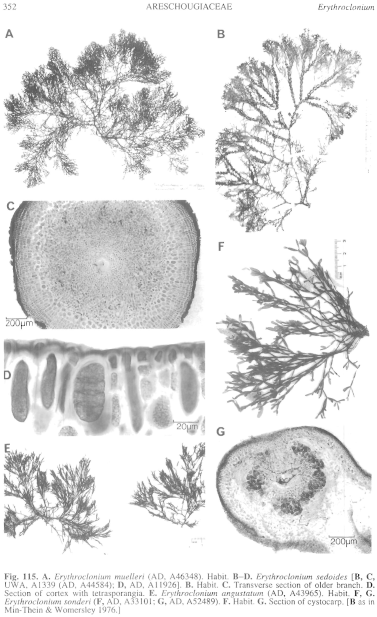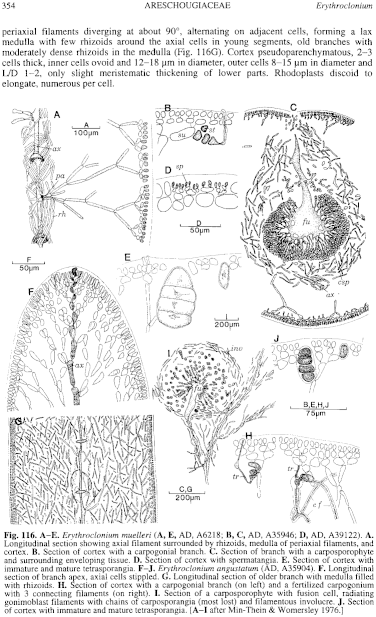|
|
|
|
|
|||||||||||
|
Electronic Flora of South Australia Species Fact Sheet
Phylum Rhodophyta – Class Florideophyceae – Order Gigartinales – Family Areschougiaceae
Selected citations: J. Agardh 1876: 278; 1897: 37 Fuhrer et al. 1981: pl. 64. Harvey 1860a: 322; 1863, pl. 298. Kützing 1866: 25, pl. 72d-e. Kylin 1932: 36; 1956: 289, fig. 220B. Lucas & Perrin 1947: 170. Min-Thein & Womersley 1976: 75, figs 27, 28, 59B.
Thallus (Fig. 115A) medium to dark red, 5–22 cm high, profusely branched with main branches subdichotomous to alternate and above with whorls of branches from the apices of elongate-ovoid segments (2–) 3–5 mm long and 0.5–1 (–1.5) mm in diameter, usually with unbranched or once branched terminal segments 2–4 mm long; lower branches becoming thickened and terete, 1–2 (–3) mm in diameter, usually denuded and without adventitious branchlets. Holdfast discoid, 2–5 mm across, with 1 (–2) axis branched close to the base; epilithic. Structure (Fig. 116A) uniaxial, with the axial filament remaining large and distinct throughout the thallus, each cell bearing two periaxial filaments more or less at right angles and alternating on successive cells, forming a lax medulla of branched filaments; rhizoids twisted around the axial filament from an early stage, and in thickened lower branches filling the medulla. Cortex pseudoparenchymatous, (1–) 2–3 cells thick, inner cells ovoid and 10–20 µm in diameter, outer cells isodiametric and 8–12 µm across, becoming meristematic below to form a cortex 20–30 cells thick. Rhodoplasts discoid to elongate, many per cell.
Reproduction: Sexual thalli dioecious; non-procarpic. Carpogonial branches (Fig. 116B) 3 (–4)-celled, borne singly on elongate medullary cells adjacent to the cortex, directed inwards with reflexed trichogynes, with the basal cell(s) often bearing sterile cells. Connecting filaments single, unbranched. Auxiliary cell an outer medullary cell with adjacent cells producing branched chains of small nutritive cells. First gonimoblast initial inward, later radial from the large fusion cell (Fig. 116C) connected to a fusion stalk from the medullary filament, with short chains (terminally mature) of ovoid carposporangia 12–18 µm in diameter. Cystocarps within the medulla, with enveloping tissue of laxly entangled filaments, ostiolate. Spermatangia (Fig. 116D) scattered, with surface cortical cells cutting off 3–5 initials each of which forms 2–3 ovoid spermatangia 2–4 µm in diameter.
Tetrasporangia (Fig. 116E) scattered in the cortex, formed from inner cortical cells and pit-connected laterally to other cells, protruding into the medulla, ovoid, 80–130 µm long and 40–65 µm in diameter.
Type from Lefevre Pen., S. Aust.; lectotype in MEL, 44760, isolectotypes MEL, 44493, 44763.
Selected specimens: 7 mile beach, N of Dongara, W. Aust., 1–2 m deep (Kirkman, 17.ix.1979; AD, A51308). Safety Bay, W. Aust., drift (Womersley, 18.viii.1979; AD, A50766). Point Sinclair, S. Aust., drift (Womersley, 25.i.1951; AD, A13858). Waldegrave I., S. Aust., 23 m deep (Shepherd, 11.v.1971; AD, A38744). Northern Spencer Gulf, S. Aust., 12 m deep (Shepherd, 5.ix.1973; AD, A44170). Tiparra Reef, S. Aust., 6 m deep (Shepherd, 24.vi.1970; AD, A35946 and 2.iv.1971; AD, A39122). Semaphore South, S. Aust., 10 m deep (Branden, 19.vi.1975; AD, A46348). Moana Beach, S. Aust., drift (Min-Thein, 11.vii.1970; AD, A35960). Emu Bay, Kangaroo I., S. Aust., 8 m deep (URG divers, 12.iv.1963; AD, A26338). Pennington Bay, Kangaroo I., S. Aust., reef pool (Womersley, 1.xi.1947;
Distribution: Geographe Bay, W. Aust., to Port Phillip, Vic., and around Tasmania.
Taxonomic notes: AD, A6218). Dutton Bay, Portland, Vic., drift (Womersley, 13.iv.1959; AD, A22677). N end Waratah Bay, Vic., drift (Sinkora A2329, 11.iii.1976; AD, A48385). N of Badger I., NW Cape Barren I., Bass Strait, 15 m deep (McCauley, 22.ii.1990; AD, A60470). Kinghorne Point, Bruny I., Tas., 8 m deep (Blackman, 18.ii.1979; AD, A58522).
Erythroclonium muelleri is similar in habit to Rhabdonia verticillata but lacks the short adventitious branchlets on the lower axes and has a conspicuous central filament throughout.
References:
AGARDH, J.G. (1876). Species Genera et Ordines Algarum. Vol. 3, Part 1 - Epicrisis systematis Floridearum, pp. i-vii, 1–724. (Weigel: Leipzig.)
AGARDH, J.G. (1897). Analecta Algologica. Cont. IV. Acta Univ. lund. 33, 1–106, Plates 1, 2.
HARVEY, W.H. (1860a). Algae. In Hooker, J.D., The Botany of the Antarctic Voyage. 111. Flora Tasmaniae. Vol. II, pp. 321–343, Plates 185–196.
HARVEY, W.H. (1863). Phycologia Australica. Vol. 5, Plates 241–300, synop., pp. i-lxxiii. (Reeve: London.)
KÜTZING, F.T. (1866). Tabulae Phycologicae. Vol. 16. (Nordhausen.)
KYLIN, H. (1932). Die Florideenordnung Gigartinales. Lunds Univ. Årsskr. N.F. Avd. 2, 28 (8), 1–88, Plates 1–28.
KYLIN, H. (1956). Die Gattungen der Rhodophyceen. (Gleerups: Lund.)
LUCAS, A.H.S. & PERRIN, F. (1947). The Seaweeds of South Australia. Part 2. The Red Seaweeds. (Govt Printer: Adelaide.)
MIN-THEIN, U. & WOMERSLEY, H.B.S. (1976). Studies on southern Australian taxa of Solieriaceae, Rhabdoniaceae and Rhodophyllidaceae (Rhodophyta). Aust. J. Bot. 24, 1–166.
SONDER, O.W. (1853). Plantae Muellerianae. Algae. Linnaea 25, 657–709.
The Marine Benthic Flora of Southern Australia Part IIIA complete list of references.
Publication:
Womersley, H.B.S. (14 January, 1994)
The Marine Benthic Flora of Southern Australia
Rhodophyta. Part IIIA, Bangiophyceae and Florideophyceae (to Gigartinales)
Reproduced with permission from The Marine Benthic Flora of Southern Australia Part IIIA 1994, by H.B.S. Womersley. Australian Biological Resources Study, Canberra. Copyright Commonwealth of Australia.
Illustrations in Womersley Part IIIA, 1994: FIGS 115A, 116 A–E.

Figure 115 enlarge
Fig. 115. A. Erythroclonium muelleri (AD, A46348). Habit. B–D. Erythroclonium sedoides [B, C, UWA, A1339 (AD, A44584); D, AD, A11926]. B. Habit. C. Transverse section of older branch. D. Section of cortex with tetrasporangia. E. Erythroclonium angustatum (AD, A43965). Habit. F, G. Erythroclonium sonderi (F, AD, A33101; G, AD, A52489). F. Habit. G. Section of cystocarp. [B as in Min-Thein & Womersley 1976.]

Figure 116 enlarge
Fig. 116. A–E. Erythroclonium muelleri (A, E, AD, A6218; B, C, AD, A35946; D, AD, A39122). A. Longitudinal section showing axial filament surrounded by rhizoids, medulla of periaxial filaments, and cortex. B. Section of cortex with a carpogonial branch. C. Section of branch with a carposporophyte and surrounding enveloping tissue. D. Section of cortex with spermatangia. E. Section of cortex with immature and mature tetrasporangia. F–J. Erythroclonium angustatum (AD, A35904). F. Longitudinal section of branch apex, axial cells stippled. G. Longitudinal section of older branch with medulla filled with rhizoids. H. Section of cortex with a carpogonial branch (on left) and a fertilized carpogonium with 3 connecting filaments (on right). I. Section of a carposporophyte with fusion cell, radiating gonimoblast filaments with chains of carposporangia (most lost) and filamentous involucre. J. Section of cortex with immature and mature tetrasporangia. [A–I after Min-Thein & Womersley 1976.]

|
Email Contact: State Herbarium of South Australia |

|